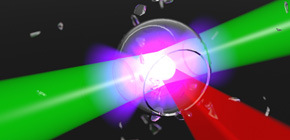
Success in heating fusion fuel to 20 million℃, hotter than the core of the sun, using LFEX, world’s largest laser
One step closer to the formation of a “man-made sun”
A group of researchers led by KITAGAWA Yoneyoshi (Specially Appointed Professor, The Graduate School for the Creation of New Photonics Industries) and ARIKAWA Yasunobu (Instructor, Institute of Laser Engineering, Osaka University) in cooperation with research institutes such as the High Power Laser Group Development Department at Hamamatsu Photonics, and Toyota Motor Corporation, among others, utilizing LFEX, the world’s largest petawatt laser located at Osaka University’s Institute of Laser Engineering, were successful in heating fusion fuel to a temperature of about 20,000,000℃. The group also succeeded in setting a new record in neutron yield through fast ignition, an advanced technique in laser fusion. This group has taken the next step in the ignition of fusion fuel and demonstrated the potential of fast ignition.
Abstract
A novel direct core heating fusion process is introduced, in which a preimploded core is predominantly heated by energetic ions driven by LFEX, an extremely energetic ultrashort pulse laser. Consequently, we have observed the D(d,n) 3 He-reacted neutrons (DD beam-fusion neutrons) with the yield of 5×10 8 n/4π sr. Examination of the beam-fusion neutrons verified that the ions directly collide with the core plasma. While the hot electrons heat the whole core volume, the energetic ions deposit their energies locally in the core, forming hot spots for fuel ignition. As evidenced in the spectrum, the process simultaneously excited thermal neutrons with the yield of 6×10 7 n/4π sr, raising the local core temperature from 0.8 to 1.8 keV. A one-dimensional hydrocode STAR 1D explains the shell implosion dynamics including the beam fusion and thermal fusion initiated by fast deuterons and carbon ions. A two-dimensional collisional particle-in-cell code predicts the core heating due to resistive processes driven by hot electrons, and also the generation of fast ions, which could be an additional heating source when they reach the core. Since the core density is limited to 2 g/cm 3 in the current experiment, neither hot electrons nor fast ions can efficiently deposit their energy and the neutron yield remains low. In future work, we will achieve the higher core density (>10 g/cm 3 ); then hot electrons could contribute more to the core heating via drag heating. Together with hot electrons, the ion contribution to fast ignition is indispensable for realizing high-gain fusion. By virtue of its core heating and ignition, the proposed scheme can potentially achieve high gain fusion.
To learn more about this research, please view the full research report entitled " Direct Heating of a Laser-Imploded Core by UltraIntense Laser-Driven Ions " at this page of the Physical Review Letters website.
Related links
